Professional conflict sim ponderer Arrigo Velicogna has very kindly agreed to assess some cardboard solitaire wargames for Tally-Ho Corner. In his second piece the ex King’s College London lecturer takes a look at a naval diversion in which “planning is essential, but plans are useless”.
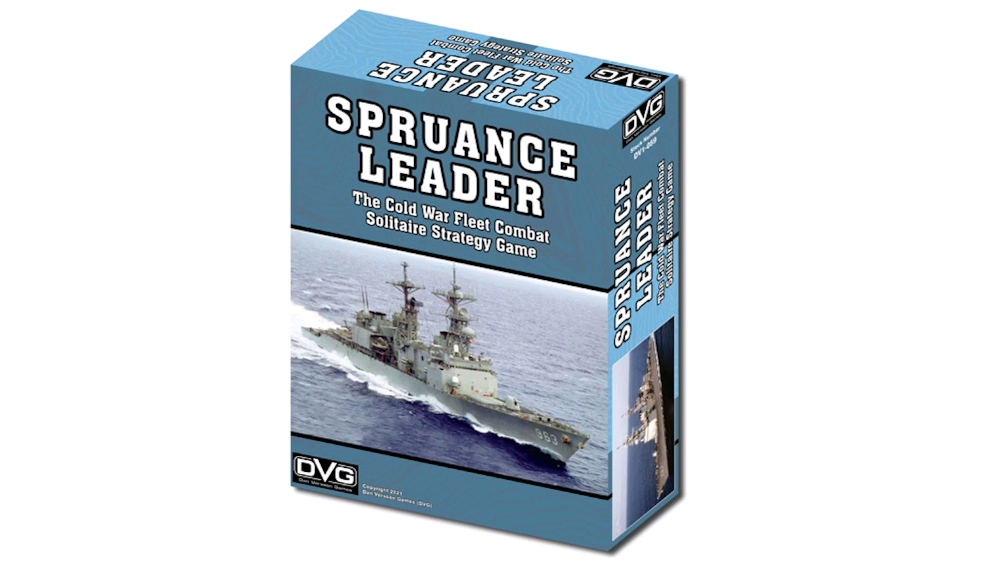
“Having previously donned the flying jacket of a Luftwaffe fighter pilot and furballed over occupied Europe, today allow me to take you to a different world, that of the cold and warm waters of a Cold War turned quite hot. Published in December 2022 Spruance Leader is a Dan Verssen Games offering covering the roaring Eighties at sea. It is one of the latest (the last one published was Stuka Leader, but others are in the pipeline) iteration of the venerable Leader series, a series that had its origins with one of the colossi of the field, GMT.
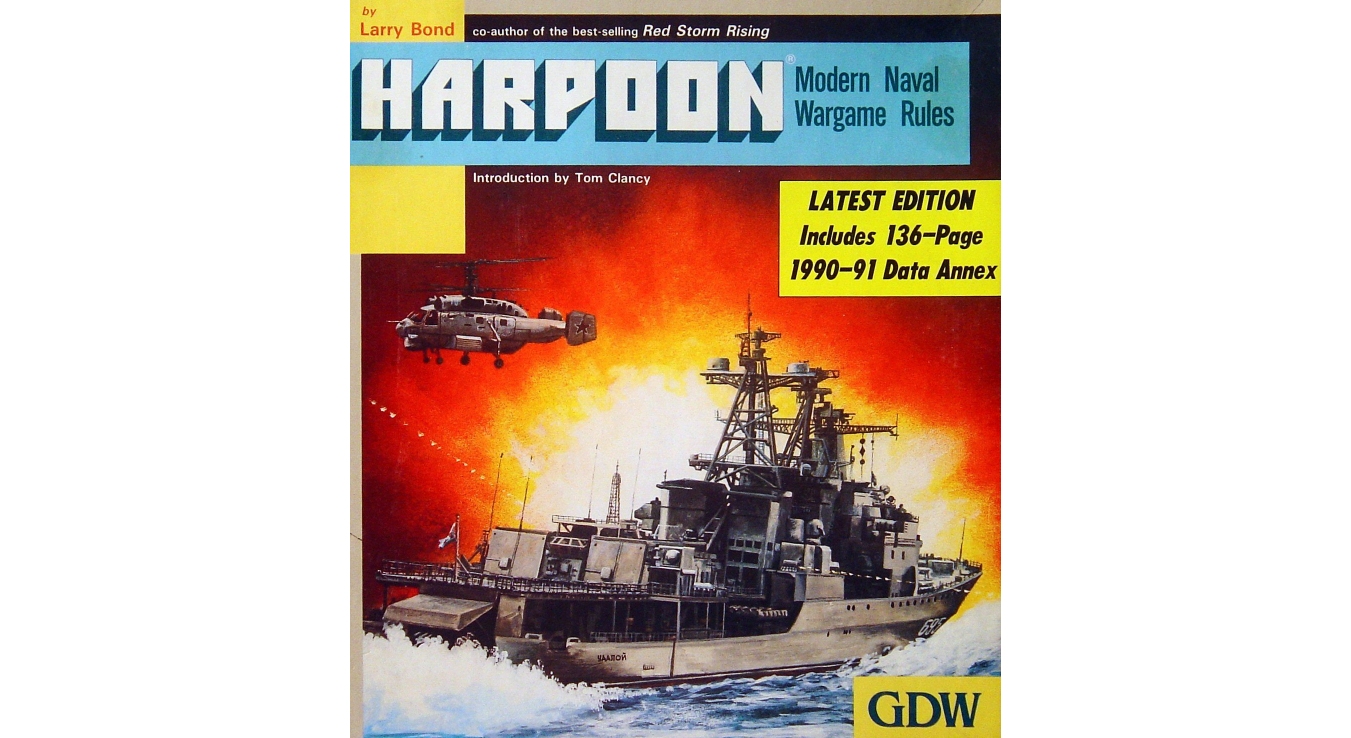
In the past if one wanted to play decent analogue games on Cold War naval warfare the choice was extremely limited: Harpoon or the Fleet series. All other attempts either failed, or resulted in strange products like Breaking the Chains, and Cold War/Modern Naval Battles. While the Fleet Series is fairly solo-friendly, Harpoon, rooted as it is in detection and evasion, is not. Not that you can’t play it solo, I did plenty of times, but well… you lose a lot. It is also a game not for the faint of heart, or people who want to play everything at once. There were attempts to bring the subject to solitaire gaming, the most notable being Carrier Battlegroup Solitaire from Decision Games, but none was completely convincing. Then, late last year, DVG released Spruance Leader and its expansions*.
* Carrier and SSN will be the subject of a follow-up post.
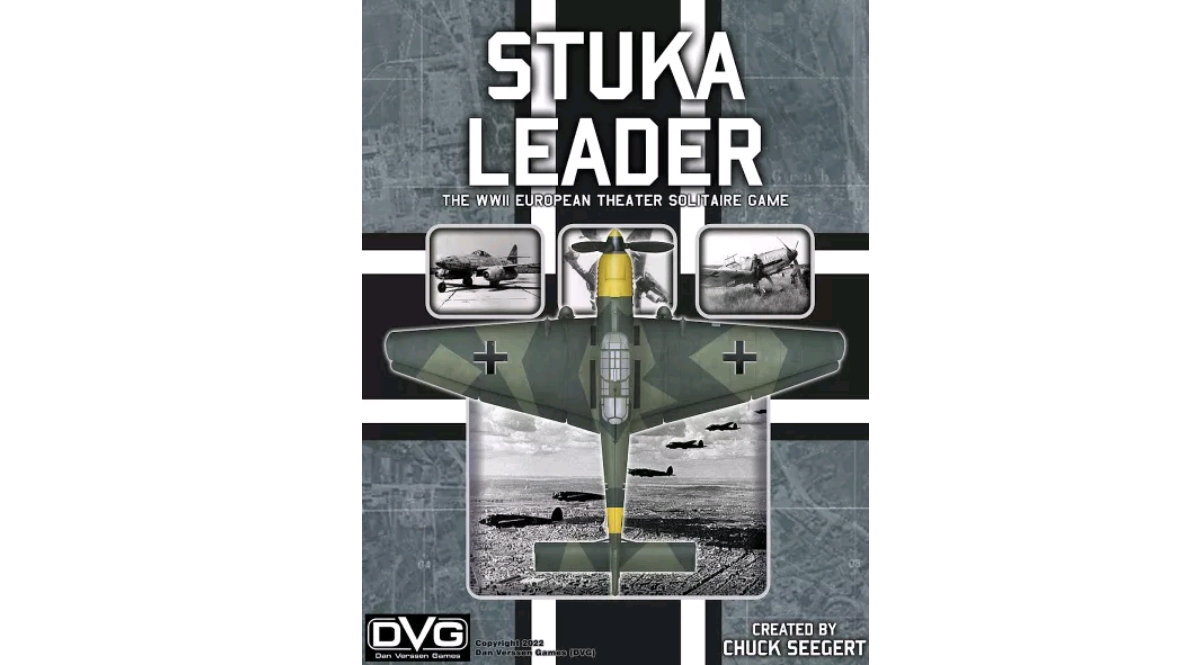
DVG has a chequered reputation. Some of their games are good, some are, frankly, crappy. More than a few of their releases sport bugs (misprints, badly written rules, signs of inadequate playtesting…), and occasionally their research isn’t stellar (I am still trying to get over Erich Hartmann flying a Bf-109… E!). At times series conventions feel more important than thematic fidelity.
All Leader games have some features in common: mainly d10 hit rolls for weapons, upgradeable experience levels (always six whether they are needed or not), target cards, ‘stress’, XP, and ‘shaken’ levels. Frequently there are expansions to milk your wallet… expand your horizons. These shared elements can feel a tad ‘rinse and repeat’. Sometimes, as in the case of Spruance, the designers manage to integrate them in a coherent object that feels satisfying and well crafted.
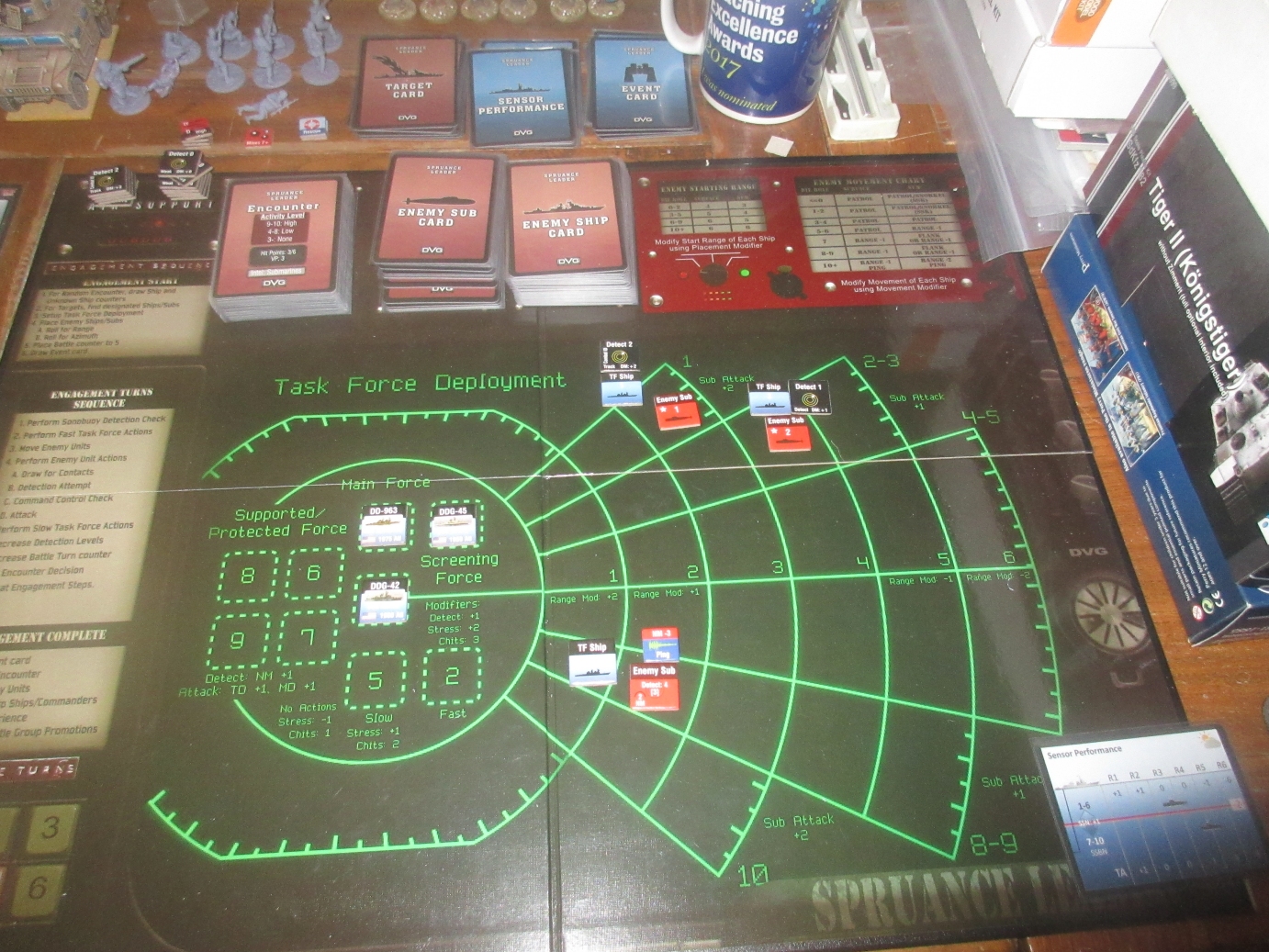
Opening the box of the core module you find it well packed* with high-quality components. There’s rules, a mounted tactical display, a slew of campaign cards and player aids, scores of very thick rounded counters, and numerous cards.
* Perhaps too well packed. It barely fits the core game and the basic expansion. If you also have Carrier and SSN, it’s too small!
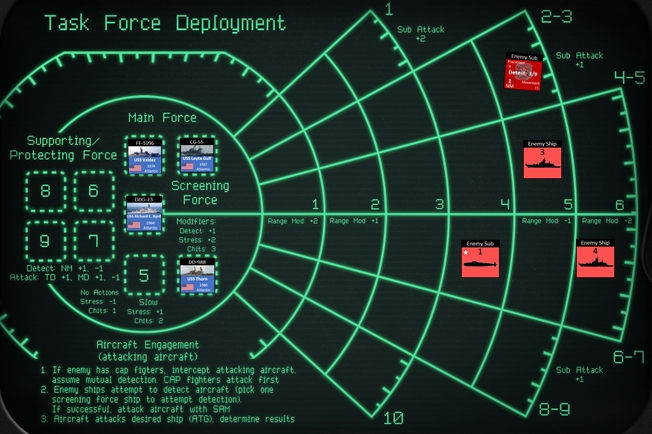
Bordered by essential tables, the tactical display imitates a radar screen with your task force on one side, the focus of a series of enemy approach vectors. Although the game posits a single enemy attack axis, or at least implies it (forget wheelbarrow attacks) the axis is divided into different azimuths allowing red forces to flank your task force.
The TF space is divided into main, screening, and supporting/protected force areas. While heavily abstracted compared to more detailed games, the shorthand works and reflects some of the main positioning dilemmas in modern naval warfare. Also, in a departure from the true and tried Leader formula, the position of a ship in the task force determines when (before or after the enemy) it can perform actions.
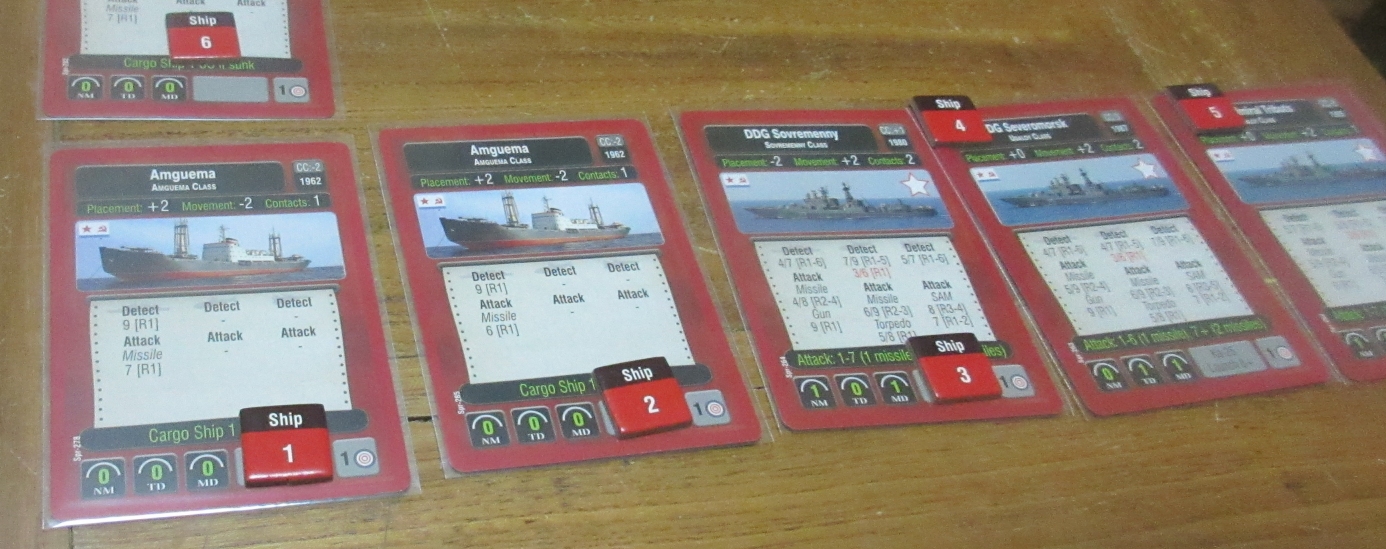
Allied ships are represented by cards and named counters, while red team vessels have detailed cards but generic counters. The cards are busy but not excessively so. Still, I recommend grabbing the ship displays from BGG so as to have space for placing the counters without cluttering the cards themselves.

This time DVG opted to illustrate with photographs rather than art. In the light of some of their recent efforts, this is probably a good thing. Beside ship, sub, aircraft, sonobuoy, and decoy markers, you have munition counters aplenty. Weapon-wise, almost everything the US Navy carried in the Eighties is included. There are Falklands War-era British missiles and torpedoes, and owners of the the Allied expansion get French and Italian kit. The ordnance follows the standard Leader approach with to-hit number (roll that or higher on a d10) range, and cost in special options points. The fact that some weapon counters don’t have an alternative weapon on the flip side feels like a bit of a wasted opportunity. However, all in all, the components are excellent.
I will not dwell on the rules because they are freely available on BGG and you can peruse them at your leisure. Select a campaign, choose ships, and then perform your mission… the approach is very similar to that used in other Leader titles. That said, Spruance is one of the most, if not the most, detailed Leader game I’ve tried. Someone on BGG called it extremely complex, but I’d argue it’s not.
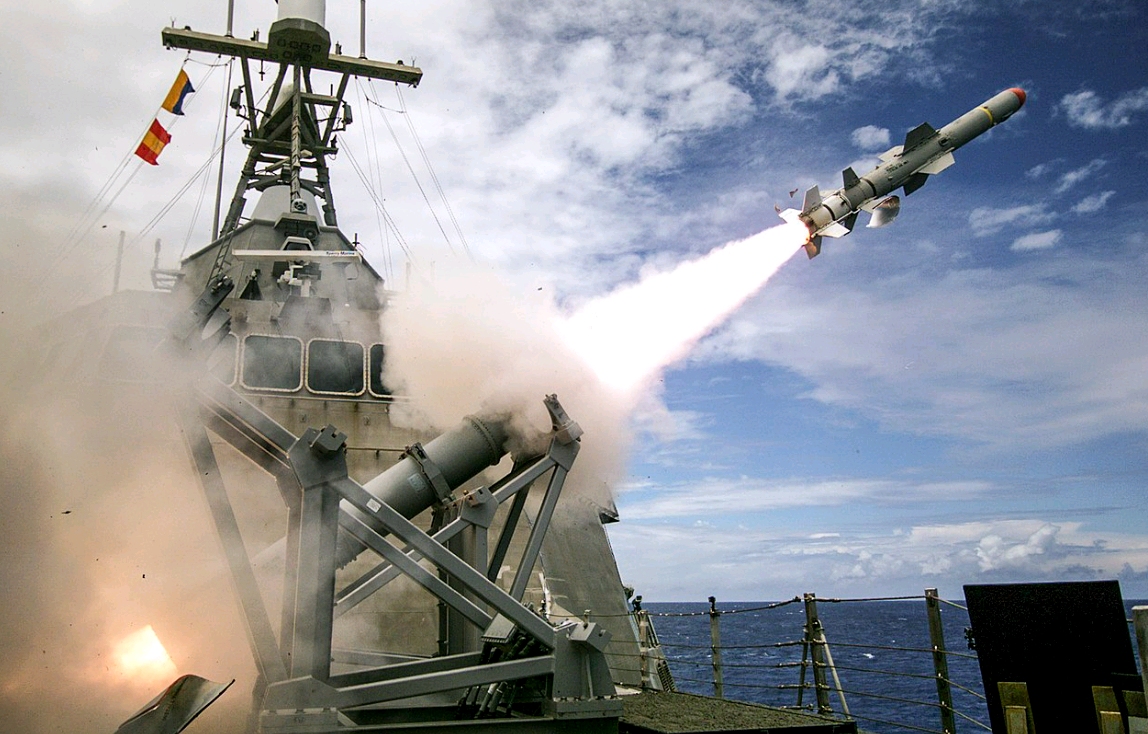
Because both you and your opponent must detect targets before firing, the cat and mouse that is modern naval warfare is crisply conveyed. Ships are rated for sensor capability against different targets (air, surface, subsurface). There are four levels of detection (the higher the level, the easier a target is to attack) and detection fades over time. It is also worth noting that even top tier weapons like Harpoons have a base 7+ to hit so the modifiers associated with detection level are very important.
Some ordnance is sufficiently smart to self-detect targets. You fire in the direction of the enemy, and the munition will try to detect targets as it travels. This can be useful in some situations, but it can also result in wasted ordnance.
To a certain extent Spruance takes all the detail of games like Harpoon but tries to the keep mathematical and the mnemonic complexity low. Taking detection as an example, the basic detection numbers on the cards are modified by range and unit experience (friendly unit experience can improve with time). Crave more detail? Optional sensor performance cards provide modifiers related to weather and water conditions to those who want it.
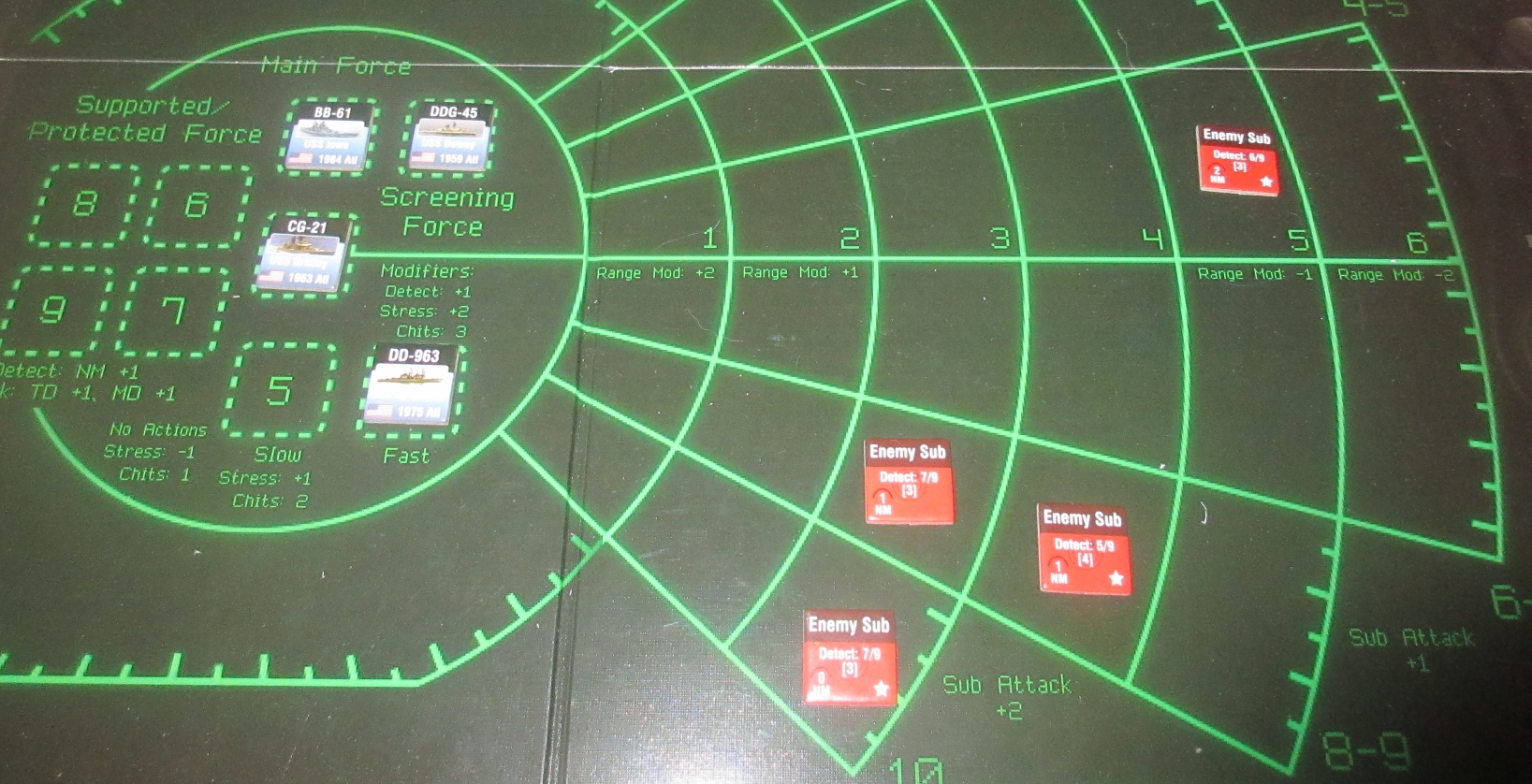
Antisubmarine warfare is modelled with similar adroitness and economy. Pithy encapsulations of active and passive sonar differences, sonobuoys, the thermal layer, range bands, and even convergence zones in different sea conditions, communicate subtleties without scuppering pace or playability. Being able to provide this level of detail in a such a rule-light package is impressive.
Except in rare cases enemy subs start as sub contact counters drawn randomly. The counter has basic information on it, but it will be a generic counter until it detects or is detected. A d10 roll determines whether it is a neutral sub, an enemy one, or nothing (being an avid fan of Tom Clancy and Larry Bond, I prefer the term ‘biological’). Each counter has a range of variations in these three possibilities. If the thing is actually a real enemy sub you draw a sub card. There is also an optional rule with a provision that if the sub detects you first, it is an enemy sub by default.
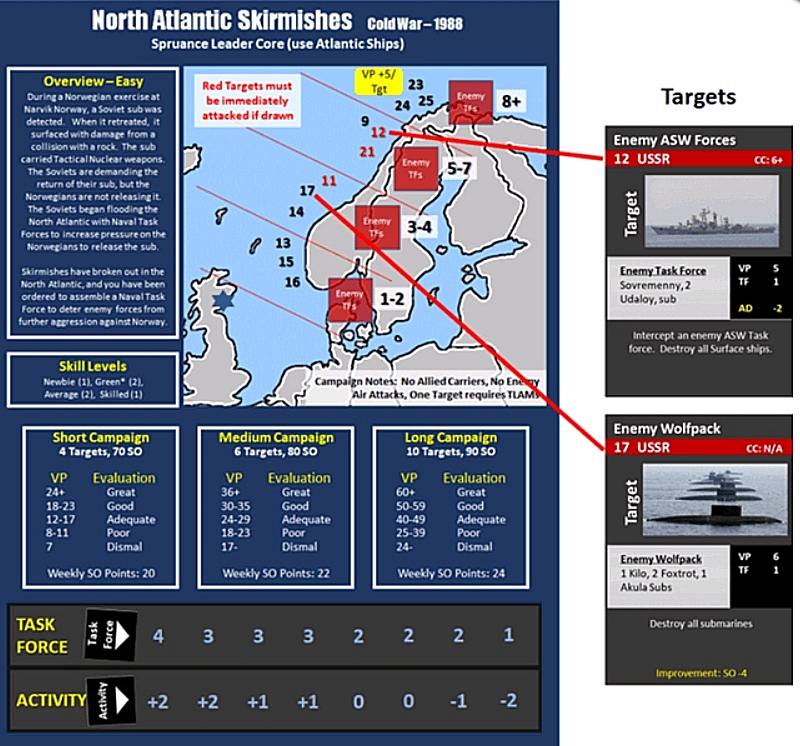
All these elements mesh well in the campaigns. Breaking series tradition, Dean Brown, Spruance Leader’s designer, has put a lot of effort into making each campaign feel unique. While the basic sequence of play is the same, each contains specific elements. For example, in some campaigns you travel across hostile waters ripe with possible enemy encounters after sortieing out from your base. In others you try to keep on station as long as possible acting as a barrier to an enemy TF, or try to escort a damaged force back to base. Hunting subs in the Norwegian Sea… using TLAMs to attack land targets in the Med… escorting convoys across ‘The Pond’… recreating historical engagements in the South Atlantic… there’s no shortage of variety.
When you start playing you quickly realise Spruance Leader is a game where plans are useless, but planning is essential. You need to consider numerous eventualities before leaving port. A simple ASW sweep can rapidly morph into something quite different – something in which surface-to-surface or surface-to-air capability is crucial. By the same token, damage also affects your ships in different ways. You have hull points, yes, but also damage markers that you draw when hit. The effect of these varies from near misses and ‘stress’ penalties to specific system damage. A hit can make your main air defence ship useless for example.
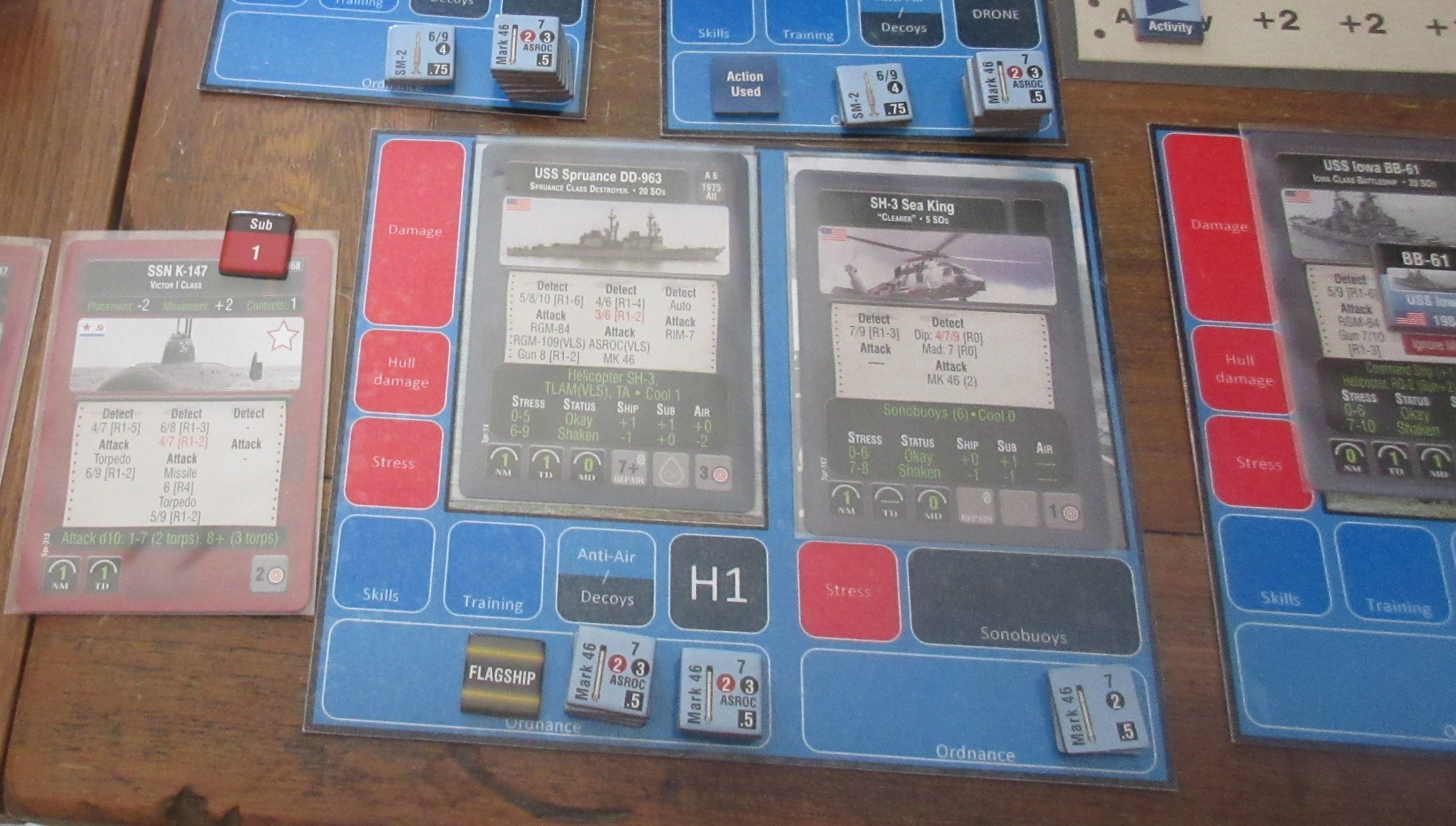
After multiple plays I’d classify Spruance Leader as ‘Harpoon light’. It is not the bland, run-of-the-mill Leader game that sometime lands in your laps (I’m looking at you Stuka Leader). The ships perform plausibly and have distinct strengths and weakneses. Compare for example a VLS Spruance-class destroyer with a Leahy-class cruiser. The former is a premier ASW platform with excellent sonar capabilities and towed arrays. The latter is… well… what I can say… it’s not designed for ASW operations. The two ships both carry Harpoon and ASROC, but the Leahy’s sonar capabilities are subpar and also the radar is not the best for surface operations. Of course the Leahy was designed for anti-air missions and it carries SM-1 Standard missiles compared to the RIM-7 Sea Sparrow of the Spruance.
Being a solitaire game, Spruance relies a lot on card draws, random rolls, and tables for managing the opponent. While the system isn’t complex, it regularly generates suspense, and rarely produces unbelievable results. Each individual enemy ship or sub has its own specific modifiers for placement and movement. Cargo or supply ships will usually be detected farther away but will try to keep their distance from the player’s TF. Quiet submarines will appear closer to the player ships and move more aggressively, even attempting flanking manoeuvres. Different platforms behave in different ways.
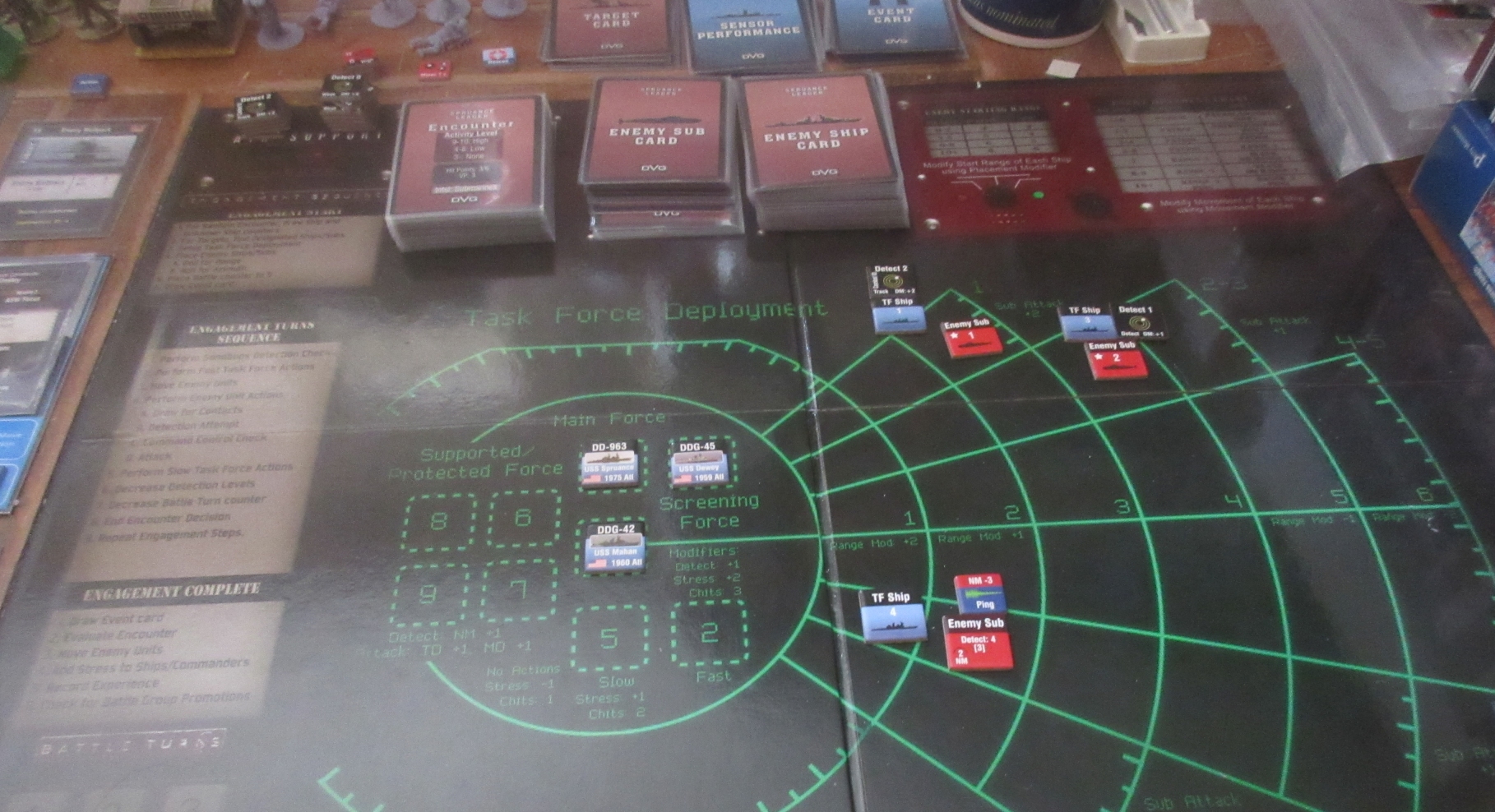
DVG has a reputation for gremlin-infested games and SL isn’t a complete break from tradition. Here, while there is no game-wrecking stuff, I did notice some spelling errors, and a couple of cards with incorrect pictures. French players won’t be pleased to see a picture of an Invincible-class flight deck cruiser (light carrier if you prefer…) on their Foch carrier card. Yet Dean Brown, active on BGG and Facebook, is noting all these issues and is addressing them. He has also produced a new rulebook in a completely different format that will surely help new players.
Anyway, minor gripes aside, Spruance Leader is an excellent game and a sound simulation. Rich and realistic enough to provide tactical insights, it should please anyone interested in Cold War naval operations. To me it’s a ‘must buy’, and certainly one of the best games DVG has ever released.”

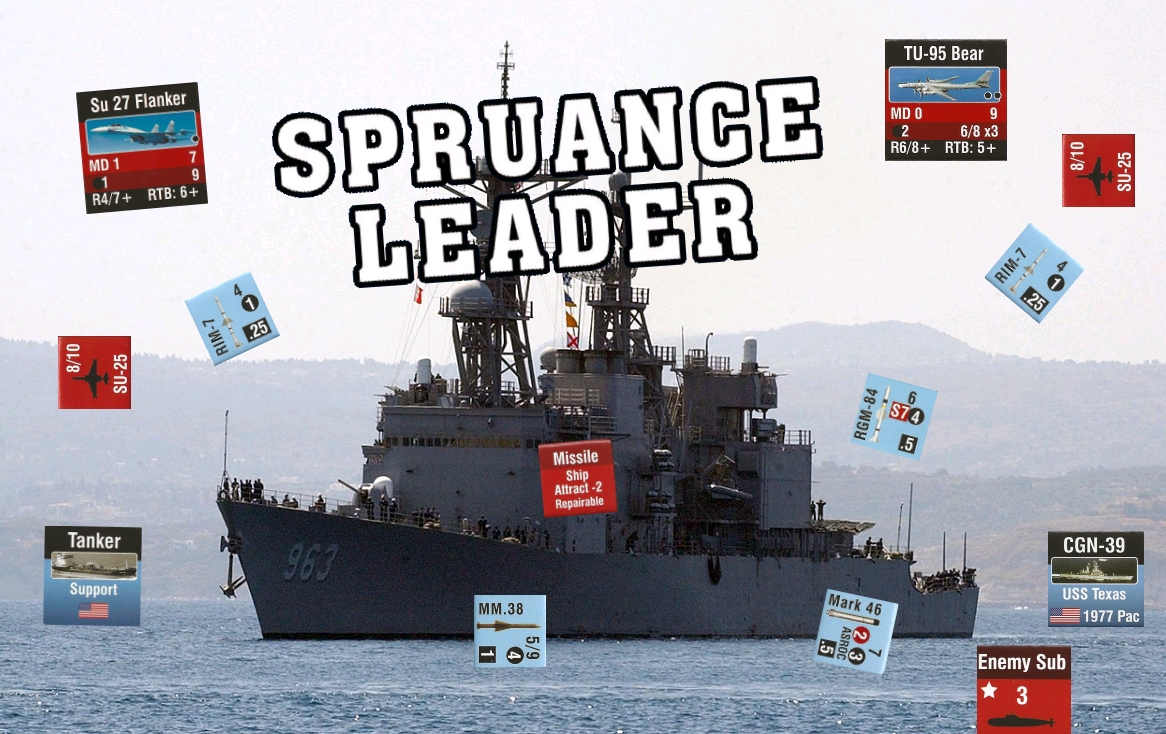
Very nice review! This game had not been on my (ahem) radar before, and that has changed!
I would like to see this game system applied to the Falklands campaign, if possible. I think that would be a good fit.
” recreating historical engagements in the South Atlantic… ”
there is a standard surface campaign for the Falklands in the core box, and also a carrier one in the carrier expansion… and yes there are both the ARA Belgrano and the HMS Conqueror. As a nice touch in the leader card the late and missed Admiral Woodward is included. There should have been also a Commodore Clapp… but they did not include him. The surface Falkland campaign is worth playing because it uses a different approach. Instead of drawing mission cards you select your mission and perform it. You have landing missions and exclusion zone missions. You have specific Royal Navy ships available at the start of the campaign.